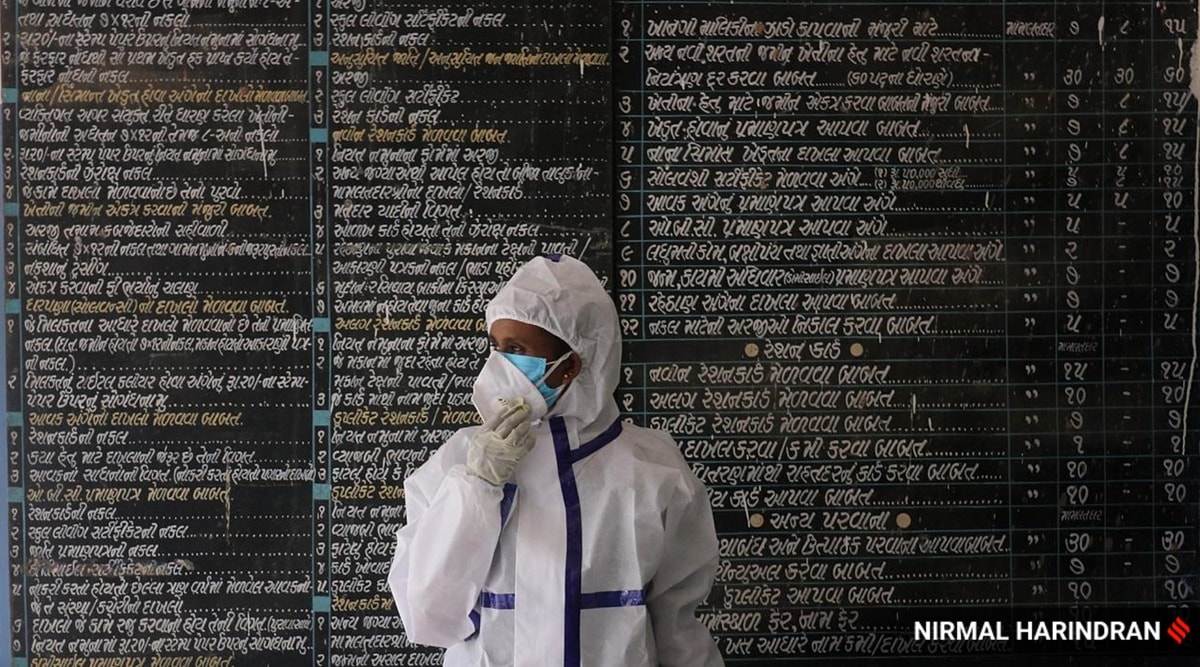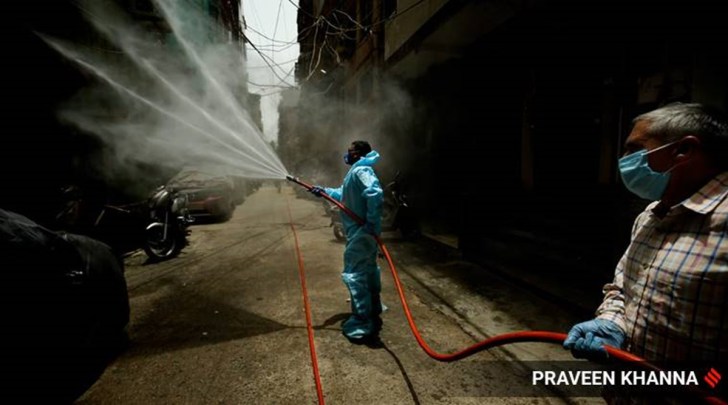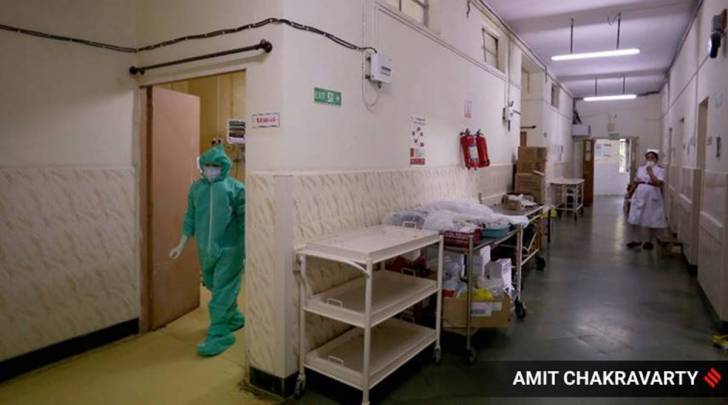
Updated: September 25, 2020 7:25:59 am
 A health worker taking off PPE after finishing the collection of the covid test sample at Taluka’s office in Detroj village, Ahmedabad district. (Express photo by Nirmal Harindran)
A health worker taking off PPE after finishing the collection of the covid test sample at Taluka’s office in Detroj village, Ahmedabad district. (Express photo by Nirmal Harindran)
As India’s coronavirus numbers continue to grow, some promising signs from the past few days offer a glimmer of hope, albeit temporarily.
Wednesday was the sixth day in a row that the number of people recovering from the disease, as reported in government data, exceeded detection of new infections. Never before had this happened for more than a day, and those occasions were due more to anomalies in the data report than to the representation of a trend.
The result has been that the number of active cases has started to show a downward trend for the first time. Active cases have dropped from a high of 10.17 lakh on September 17 to 9.66 lakh now. For the spread of an epidemic, only active cases matter, because they are the ones that transmit the disease to others. Furthermore, only active cases require medical attention, so a reduction in active cases reduces the burden on the health system.
In an epidemic like this, a clear trend of recoveries outpacing new infections is eagerly awaited, because it can be interpreted as indicating a slowdown in spread. These are still very early days, the trend must continue for several weeks to convey something more meaningful, but the fact that it has started brings hope.
Additionally, the reproduction number, or R, a key epidemiological metric that indicates how fast the disease is spreading in a population, has fallen below 1 for the first time since the pandemic began in India in the first week of March. . The R-value is a measure of the number of people who, on average, are being infected by an already infected person. A value less than 1 means that fewer people are contracting the infection than those who are carriers of the disease at this time.
Explained: How CSIR Will Try To Find Out If Coronavirus Can Spread Through The Air
The current R-value in India as a whole, calculated by a team of researchers led by Sitabhra Sinha at the Institute of Mathematical Sciences (IMSc) in Chennai, is 0.93. This means that, on average, 100 infected people transmit the disease to only 93 others.
The R-value that falls below 1 is another highly anticipated indicator, because it can also indicate the beginning of the end of the epidemic.
However, there are important caveats.
The R value is not an absolute metric. Different researchers can arrive at different R-values, depending on the computer models they use and the assumptions they make in their calculations. But general upward or downward trends are generally captured uniformly across all models. The Indian Express has been reporting the R-values calculated by Dr. Sinha’s team since the beginning of the pandemic and, in their calculation, this value has dropped below 1 for the first time.
Read | India’s coronavirus numbers explained: top five states show downward trend
Furthermore, there are inherent uncertainties in estimating R values while the epidemic is still developing.
The national trend towards a decrease in the R value is also reflected in the most affected states. Thus, in the five states with the most coronavirus cases, the R-values are less than 1 at this time (see chart), and this has happened for the first time in all of these states.
 Sanitation in a containment zone at Reghar Pura in New Delhi on Monday.
Sanitation in a containment zone at Reghar Pura in New Delhi on Monday.
Furthermore, over several days in the past two weeks, these worst affected states – Maharashtra, Andhra Pradesh, Tamil Nadu, Karnataka and Uttar Pradesh – have reported more recoveries than new cases. Active cases in each of these states have declined in recent days, most notably in Andhra Pradesh, where there has been a 10 percent drop in the past two weeks.
What this means is that national trends are closely related to the situation on the ground, and are not skewed by the disproportionate influence of one or a few states, as had been happening until a few months ago, when Maharashtra counted 40. percent of the number of national cases. The trends appear to be more evenly spread across multiple states now, even outside of the big five.
However, it is not clear what is driving these trends.
The most optimistic guess would be that the virus has already infected more than half the population. But we know from serological surveys in several cities that this has not happened yet; only some areas of Pune have shown a prevalence of the disease of more than 50 percent; in most other cities, the infection rate is much lower.
These trends can also be the result of political interventions such as blockades and movement restrictions. A reduction in interactions between people can cause a drop in the R value. But since the lifting of the harsh March-April blockade, the government has not intervened in the way that can be expected to produce such a result.
Theoretically, strict physical distancing and universal adoption of face masks and coverings could be one reason, but again, anecdotal evidence suggests that in many parts of the country, physical distancing norms are hardly followed.
 The two dialysis machines are being purchased as two machines have stopped working after being in use for 10 years.
The two dialysis machines are being purchased as two machines have stopped working after being in use for 10 years.
That leaves us with a probable reason, which is supported by some evidence. Case finding depends on testing, and a higher number of tests will likely produce more positive results, because many more people carry the disease than are detected by testing.
Over the past week, test numbers have dropped slightly. The seven-day moving average of the number of daily tests fell to 9.81 lakh on Wednesday, the lowest this month. This average was the highest this month on September 13, with 10.98 lakh of testing.
“In the absence of any other evidence, it could be that last week’s slightly lower number of tests contributed to the R value drop. We cannot be completely sure. It is important to remember that these trends are not irreversible and can change at any time. Therefore, we must be careful that no one, neither the government nor the people, lowers their guard, ”said Dr. Sinha of the IMSc.
Something like that, in fact, has already happened in Delhi. By August, Delhi’s R-value had fallen below 1, reporting more recoveries than new infections every day for more than a month. Daily detections had fallen below 1,000 and the number of active cases in one stage dropped to nearly 10,000. However, in recent weeks, a new wave has hit the city and the number of cases has increased considerably.

For the latest news about India, download the Indian Express app.
© The Indian Express (P) Ltd
.